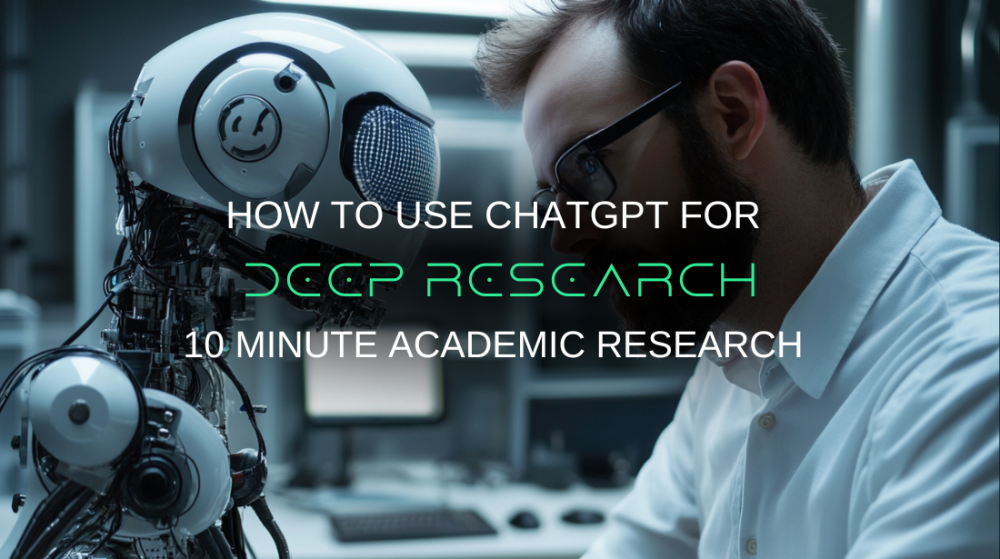Deep Research with ChatGPT - High-Level Academic Research in 10 Minutes
What if you could cut hours of research down to just 10 minutes? An AI that delivers a comprehensive, synthesised report from papers, websites, and datasets. OpenAI’s Operator AI, featuring the Deep Research agent, does just that.
The tool, previously available only in the US, is now rolling out in several other countries. It provides fast and accurate insights with minimal effort. Recently upgraded with advanced reasoning, Operator continues to evolve, making high-level academic research quicker and more efficient.
Deep Research: The 10-Minute Academic Mastery
Researchers often face the challenge of spending a significant portion of their time on administrative tasks like data collection, source searching, and formatting. With the introduction of Operator AI, this inefficiency is reduced dramatically.
Launched in January 2025, OpenAI’s Operator automates various web tasks by seamlessly interacting with online platforms. Competing with tools like Anthropic’s computer-use capabilities, Operator stands out for its user-friendly interface, which allows for plain language instructions rather than requiring programming knowledge. It processes text, images, and audio to autonomously fill forms, click buttons, and scrape data. A key feature for researchers is Deep Research, introduced in February 2025, which utilises OpenAI's GPT-4 model to autonomously browse the web, gather information, and generate detailed reports in minutes.
It doesn’t stop at scraping information. Deep Research takes it a step further by analysing the data it collects, identifying trends, and drawing connections across various sources. What would normally take a researcher several days to complete can now be done in 5 to 30 minutes.
This tool can assist in a wide range of academic activities, including:
- Literature reviews: They compile relevant academic papers, news articles, and other resources, providing a well-rounded summary of the topic at hand.
- Data analysis: By scanning available datasets, it identifies patterns and compiles data points into digestible charts or tables.
- Report generation: Whether it’s a brief summary or a detailed report, Deep Research can present findings in a structured format, ready for use in presentations, papers, or discussions.
Getting Started with Deep Research
If you’re interested in trying Deep Research for yourself, here are the steps to get started.
- Check Availability: First, ensure that you have access to Operator AI through OpenAI’s subscription plans. As of 2025, Operator is available through the Pro tier with broader access expected soon.
- Set Your Parameters: When using Deep Research, you can input specific topics or keywords for a more focused search. The tool will handle the rest, gathering and synthesizing the data into a comprehensive report.
- Verify Critical Data: While Deep Research can save you significant time, it’s always good practice to manually verify key findings or particularly critical information before using it in your research or presentations.
Key Features
1. Advanced Search and Data Aggregation
Deep Research gathers data from a vast range of sources, including online platforms, academic journals, and digital repositories. It efficiently handles complex queries, using advanced machine learning to deliver detailed summaries and comparative analyses.
2. Contextual Understanding
With powerful deep learning algorithms, Deep Research excels at understanding the context behind user queries, ensuring that the results are both accurate and highly relevant.
3. Report Generation
The tool automatically generates well-structured reports, organizing findings into concise summaries, charts, and actionable recommendations, making research outputs easier to interpret and apply.
4. Interactive Experience
Integrated with ChatGPT, Deep Research offers an intuitive, easy-to-use interface suitable for users of all technical backgrounds. Users can engage in follow-up queries, allowing them to refine or expand their research for greater precision.
5. Real-Time Updates
Deep Research continuously scans the web, incorporating the latest data to ensure up-to-date results. It integrates new information into existing summaries, helping researchers keep their findings current and relevant.

How Operator Works
Operator uses a virtual browser to navigate websites, interacting with graphical user interfaces just like a human user. Instead of relying on specialized APIs, it interprets the visual layout of a webpage to click buttons, type in fields, and scroll through content. Driven by plain-language instructions, Operator breaks tasks into actionable steps and provides feedback, asking for clarification or confirmation on critical actions like form submissions or payments. Powered by the Computer-Using Agent and GPT-4o’s vision capabilities, it combines advanced reasoning to efficiently interact with web interfaces.
Who Can Use Operator
Initially available as a research preview to Pro users in the U.S., Operator's accessibility has expanded. OpenAI's collaboration with institutions like the Bank of New York Mellon indicates a broader rollout, integrating Operator's capabilities into enterprise solutions. BNY's Eliza platform, a knowledge-based chatbot, is set to benefit from Operator's advanced features, enhancing internal processes and decision-making.
Use Cases
Operator's true potential lies in broader applications, especially in accessibility and institutional support.
1. Accessibility
Operator could be great for individuals with limited computer skills, such as the elderly or those unfamiliar with technology. By guiding users through complex online tasks, it could simplify processes that would otherwise require technical expertise. When combined with voice commands, users wouldn’t even need to type, making it even more intuitive.
For people with disabilities, such as visual impairments, Operator could make websites more accessible by interacting with web interfaces and providing audio feedback or screen-reader support. This would open up online navigation for those who typically face barriers to using digital platforms.
2. Institutional Support
Operator could have a significant impact in government and institutional settings. It can assist citizens in completing complex tasks like applying for visas, filing taxes, or accessing social benefits, reducing the need for in-person support and improving the overall user experience.
In education, Operator could streamline processes such as online applications, scholarship submissions, and research tasks, making it easier for students or those with limited digital literacy to navigate these systems efficiently.
3. Small Businesses and Professional Tasks
For small businesses, Operator can automate web-based tasks like managing inventory, processing orders, or collecting customer feedback, reducing manual workload and increasing efficiency. In professional settings, Operator could handle time-consuming workflows, such as gathering information from various sources or filling out forms, allowing professionals to focus on more strategic tasks.
4. Healthcare and Non-Profits
Healthcare organizations could use Operator to help patients fill out online registration forms or access resources, minimizing the need for staff involvement. Non-profits working in areas with low digital literacy could deploy Operator to assist underserved populations in navigating essential online systems, ensuring that technology does not become a barrier to accessing crucial services.
Benefits for Researchers
Researchers stand to gain significantly from Operator's capabilities.
- Enhanced Research Efficiency: Operator's Deep Research agent autonomously gathers and synthesizes information, producing detailed reports that aid in literature reviews and data analysis.
- Automated Data Collection: By navigating various databases and repositories, Operator collects relevant data, reducing manual search efforts.
- Improved Accuracy: Operator's systematic approach minimizes human error, ensuring reliable data aggregation and analysis.
Limitations and Considerations
Despite its advancements, Operator has its limitations, some of them are listed here.
- Ongoing Development: As a relatively new tool, Operator continues to evolve. Users should remain cautious and verify critical actions, especially when dealing with sensitive information.
- Access Restrictions: Operator's availability varies based on subscription tiers and geographic location. Users should check their eligibility and stay updated on OpenAI's rollout plans.
- Ethical Concerns: With AI handling large amounts of sensitive data, there are ethical implications to consider, especially around data privacy and potential biases in the AI’s data sources.
What’s Next for AI in Research
The introduction of AI tools like Operator and its Deep Research agent is just the beginning. The future of academic research will likely see further developments in automation, allowing even more complex tasks to be handled efficiently by AI. This could include tasks like generating hypotheses, running simulations, or even providing predictive models based on available data.
As these tools continue to evolve, the role of the researcher may shift to focus more on analysis, interpretation, and decision-making, rather than data collection and organization. This change holds the potential to accelerate progress across all fields of study.





